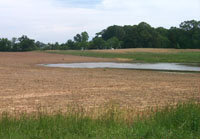Persistent Rains Delay Planting Season
Persistent Rains Delay Planting Season

Wet weather this spring has delayed corn planting in most areas of the Kentucky.
As of May 12, 55 percent of the corn crop is estimated to be planted compared to 92 percent last year and the five-year average of 72 percent, according to the Kentucky Agricultural Statistic Service.
Some areas of the state have very little corn planted by while others have missed a few of the rains and managed to get a majority of their crop in the ground, noted James Herbek, a University of Kentucky Cooperative Extension Service grains specialist.
In Daviess County, producer Mack Estes has been unable to plant any of his planned 1,000 acre corn crop. He has applied some nitrogen and herbicides, but rains constantly hamper his efforts to get into the field.
The spring has been frustrating, Estes said. He said he is at the point of trying to decide what to do about this year's planting season.
"I don't know what I'll do for sure, but I do know I will likely plant less corn than I had planned," he said.
The prime planting window to obtain an optimum yield in corn has essentially closed and the remaining corn acreage will be planted after mid May when yields will begin to drop, Herbek said. Historically, research has shown farmers can expect a 1 percent per day yield loss for corn planted after May 10.
Farmers with remaining corn to plant can suffer quite a bit of yield loss depending on how late it gets, Herbek said. Because the optimum period has passed, farmers need to concentrate on getting the corn planted and do management practices that will expedite establishing a corn crop.
"They really need to focus on planting and less on tillage, preplant fertilizer applications and preplant herbicide applications," he said. "Because if we spend time on these field activities we could further hamper corn planting when we don't have many days left to do it. Plant the corn and do some of the other activities after corn is planted."
Tillage operations should be kept to a minimum. No-till planting offers the best option to avoid further planting delays.
In many situations it will be more profitable to plant corn first then control weeds with a post planting herbicide application, Herbek said. Post planted weed control will be critical and these applications need to be made on a timely basis. There is a good array of chemicals available for post planting applications, he said.
If a grower had planned to use a preplant nitrogen application, they should consider side dressing nitrogen instead to avoid further planting delays. Side dressing after emergence provides an additional benefit of more nitrogen available for the growing corn crop and reduces the probability for nitrogen losses due to denitrification and leaching, Herbek said.
For farmers who have already applied nitrogen there may be some concern about loss due to the wet conditions.
Most nitrogen losses are due to denitrification, where the nitrogen in the soil is turned into a gas and lost, said Lloyd Murdock, a UK Extension agronomist. In order for denitrification to occur the soil has to be saturated for a couple of days for the bacteria to begin changing it from the nitrate form to gas. Once it reaches that stage, nitrate loss begins. Some upland, well drained soils can be wet but if the soil is saturated for a few days and then dries, little nitrate/nitrogen is lost.
Greater losses occur when it gets wet and stays wet for several days such as in low areas, poorly drained soils or it rains every two or three days. In those conditions, a loss in nitrate/nitrogen will occur but you only lose nitrate/nitrogen and not nitrogen still in the ammonium form, Murdock said.
This loss can be estimated by knowing what type of nitrogen fertilizer was applied and when it was applied. The nitrate/nitrogen is lost at a rate of three to 4 percent each day that the soil remains saturated after it has been saturated for two days. A soil is saturated when almost squishy, Murdock said.
Losses often aren't as severe as farmers think, he said.
Information on how to calculate nitrogen loss is available at the local county Extension office in the corn management guide.
Another consideration for farmers as the wet conditions persist, is whether to switch to an earlier maturing hybrid. Herbek said that is not necessary unless planting is delayed until late May or after. By going to an earlier hybrid, research shows there is generally less yield loss potential than a full season hybrid. Also they are more likely to mature prior to frost and to have a lower harvest moisture content. Growers may want to check on the availability of earlier maturing varieties now in case they decide to make a switch, he said.
Herbek outlined some general guidelines to use in determining whether to switch. Late maturing hybrids - 120 plus days to maturity - should be planted before June 1; full season hybrids, 116 to 120 days, can be planted up to June 5; mid season hybrids, 110 to 116 days can be planted up to June 10; and early maturing hybrids, 110 days or less, can be planted up to June 15.
Later planted corn situations will have more potential for insect problems. If planting after mid May, a grower might consider switching to a Bt corn hybrid to combat Southwestern corn borer, he said.
A last alternative may be to consider switching to grain sorghum or soybeans since they can be planted by June 1 and June 10, respectively, before yield loss potential occurs. Before making any decision, a grower needs to consider yield potential between corn at the later planting date and the other grain crop he is considering.
